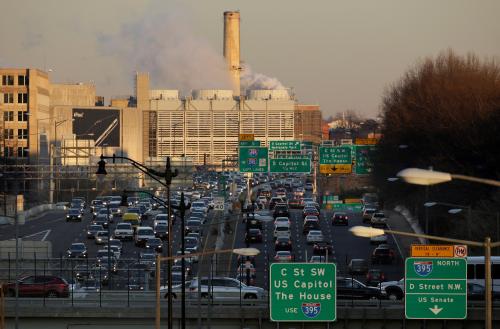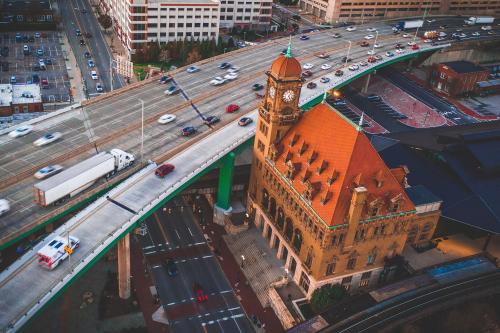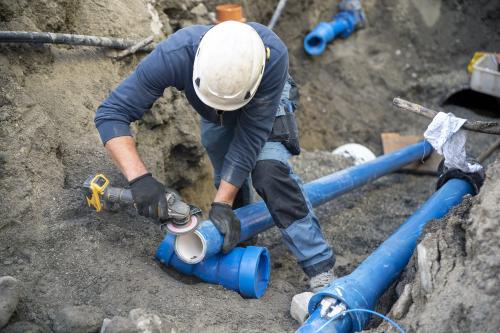Eight years ago, during the worst recession since the Great Depression, Congress passed and President Obama signed the American Recovery and Reinvestment Act. At a moment of economic peril, the Recovery Act provided a critical ‘shot in the arm’ to the American economy. It made millions of jobs possible and, in 2010 alone, lowered unemployment by as much as 1.8 percent while raising GDP by up to four percent. It was also an important step toward economic turnaround in subsequent years, with unemployment at the start of 2017 less than half of what it was at the peak of the recession.
A cornerstone of the Recovery Act was the $48.1 billion in funding for transportation infrastructure, which supported needed repairs and long-term transformative investments in communities across every state. As Congress and the president initiate a new debate around a major infrastructure package, the Recovery Act can help us see what nearly $50 billion in incremental infrastructure spending looks like in practice. In the process, it provides object lessons on the capacity of federal, state, and local governments to deliver infrastructure projects.
First and foremost, the Recovery Act—the largest public works project since the Eisenhower Interstate System—showed a quantifiable relationship between transportation investment and outcomes. Investments improved more than 42,000 miles of roads and almost 2,700 bridges; they paid for 850 new transit facilities, nearly 12,000 new buses, and nearly 700 new rail cars; and they repaired about 800 airport facilities. According to a recent analysis by the U.S. Department of Transportation (USDOT), these investments measurably improved the country’s transportation system. For example, nationwide measures of bridge quality improved during the years immediately after the Recovery Act: USDOT classified 9.3 percent of bridges as structurally deficient in 2008, a figure that dropped to 7.1 percent by 2014. If that pace of improvement, which was twice what it was during the comparable period before the Recovery Act, were to continue, the backlog of structurally deficient bridges could be cleared within 10–20 years. Consistently higher funding levels could allow that pace to continue, or even accelerate it over time. Policymakers looking to scale an investment package could use performance metrics from the Recovery Act to envision what different orders of investment magnitude might yield.
State of good repair investments tend to deliver more rapidly than longer-term capital investments; both are important, but they mature on different timelines. Congress directed much of the Recovery Act’s funding to state of good repair upgrades, such as fixing roads and bridges through nearly $28 billion for highway programs. This helped many ‘shovel-ready’ projects get underway almost immediately, and Recovery Act funding helped keep projects afloat amidst state and local budget cuts during the recession. The first project to break ground—to resurface and improve access to New Hampshire Avenue in Montgomery County, Maryland—was underway within days. All 50 states beat an aggressive statutory deadline to obligate highway funds within 120 days of enactment, a deadline that deliberately favored projects that could be executed quickly. More than 1,900 projects were under construction by June.
However, the country requires more than just state of good repair investments. Multi-phase, complex projects generally take longer to execute given factors like capital planning, permitting, and budgeting that must precede construction activity. In this case, the Recovery Act seeded a variety of forward-looking programs that supported long-term economic benefits through longer development timelines. For example, the Transportation Investment Generating Economic Recovery (TIGER) Program and high-speed rail funding were both structured to include the two latest spending deadlines for transportation program funds included in the Recovery Act (fiscal years 2016 and 2017, respectively). Programs like TIGER—which Congress has extended each year since 2009 through the annual appropriations process—and the newly established FASTLANE program, authorized at $4.5 billion for fiscal years 2016–2020, continue to support complex projects like ports, intermodal hubs, and mitigation of freight chokepoints. And these programs are oversubscribed; in 2016, USDOT received applications collectively requesting over $9.3 billion in funding for only a $500 million pot. But if funding for such programs increases in an infrastructure bill, expectations for delivery timelines must be realistic; the best candidates probably aren’t, and can’t be, shovel-ready.
Similarly, fast delivery tends to rely primarily on well-established programs; even then, there are limits to how quickly new funds can be absorbed. The federal government executed most Recovery Act transportation dollars ($38.6 billion) through established federal programs, expediting delivery by leveraging pre-existing systems and grantee relationships—e.g., with state departments of transportation, which typically execute highway formula dollars. For traditional state of good repair projects, established programs and relationships tend to be the fastest, most reliable path to execution.
Nevertheless, the Recovery Act highlighted some limitations of project sponsors to quickly absorb additional funding, even within the constraints of familiar programs. Take highway spending, for example: while Congress provided funds in a single tranche in fiscal year 2009, recipients spent those dollars through fiscal year 2012, sometimes sequencing them ahead of other federal highway funds. This resulted in elevated, but relatively consistent, actual spending (outlay) levels through fiscal year 2014. Recipients can adjust to higher funding levels, but full absorption of a funding spike still takes time and not all construction or jobs will be immediate. Generally speaking, new and more complex programs take longer to implement before shovels can ever hit the ground. This would likely delay the timeline for seeing results from an infrastructure package focused on new tax or financing incentives.
The empirical success of the Recovery Act is a testament to both the need for, and promise of, additional federal spending in America’s transportation infrastructure. The Recovery Act shows the tangible results of a significant, quantifiable investment portfolio and the ways that different types of programs can deliver results. As policymakers consider the potential of a future infrastructure investment package, they should learn from the Recovery Act’s transportation investments.
Shoshana Lew is the former Chief Financial Officer and Assistant Secretary for Budget and Programs at USDOT. John D. Porcari is the former United States Deputy Secretary of Transportation and currently President of US Advisory Services at WSP | Parsons Brinckerhoff, a former donor to the Brookings Metropolitan Policy Program. Both Lew and Porcari worked on implementation and oversight of the American Recovery and Reinvestment Act under the Obama Administration.
The Brookings Institution is committed to quality, independence, and impact.
We are supported by a diverse array of funders. In line with our values and policies, each Brookings publication represents the sole views of its author(s).








Commentary
Eight Years Later: What the Recovery Act Taught Us about Investing in Transportation
February 22, 2017